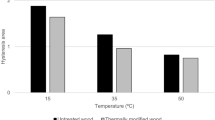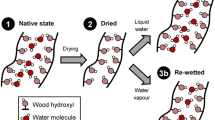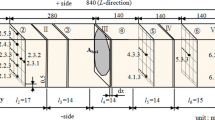Summary
The effects of air-drying and solvent-drying on the sapwood of Abies grandis have been investigated by a new method for the determination of the size and number of conducting tracheid lumina and pit membrane pores which involves the measurement of gaseous permeability at various mean pressures. Both earlywood and latewood tracheids (83% of the total) were found to be conducting in solvent-dried wood, but in air-dried wood only latewood tracheids (32% of the total) were conducting. In solvent-dried wood there were on average 27,000 pit membrane pores per conducting tracheid compared with only 600 in air-dried wood. In both, the average pit membrane pore radius was about 0.1 μm.
Liquid permeabilities have been predicted from the calculated radii and numbers. The liquid permeability of solvent-dried wood was 31 times greater than that of air-dried wood in which the lumina were responsible for 13% of the total resistance to flow. The lumina were responsible for 39% of the resistance in solvent-dried wood and it is suggested that in first-formed earlywood the lumina may cause more than half the total resistance.
A new method is described for the cleaning of direct carbon replicas of wood. In this the cellulose is removed by cellulase instead of sulphuric acid, and no wax backing is required. This provides much cleaner replicas. Electron micrographs have been obtained of both earlywood and latewood dried by the two methods.
Similar content being viewed by others
References
Adzumi, H.: On the Flow of Gases Through a Porous Wall. Bull. Chem. Soc. Japan 12 (1937) 304–312.
Carman, P. C.: Flow of Gases Through Porous Media. London 1956: Butterworths Scientific Publications.
Comstock, G. L.: Longitudinal Permeability of Wood to Gases and Nonswelling Liquids. For. Prod. J. 17 (1967) No. 10, 41–46.
— and W. A. Côté Jr.: Factors Affecting Permeability and Pit Aspiration in Coniferous Sapwood. Wood Sci. Technol. 2 (1968) 279–291.
Côté, W. A., Jr., and R. L. Krahmer: The Permeability of Coniferous Pits Demonstrated by Electron Microscopy. Tappi 45 (1962) No. 2, 119–122.
—, and A. C. Day: Replica Techniques for Electron Microscopy of Wood and Paper. Tappi 47 (1964) No. 8, 477–484.
Dushman, S.: Scientific Foundations of Vacuum Technique. New York/London 1962: J. Wiley and Sons, Inc.
Erickson, H. D., and R. J. Crawford: The Effects of Several Seasoning Methods on the Permeability of Wood to Liquids. American Wood-Preservers Association, Proceedings 55th Annual Meeting 55 (1959) 210–220.
Hart, C. A., and R. J. Thomas: Mechanism of Bordered Pit Aspiration as Caused by Capillarity. For. Prod. J. 17 (1967) No. 11, 61–68.
Krahmer, R. L., and W. A. Côté, Jr.: changes in Coniferous Wood Cells Associated with Heartwood Formation. Tappi 46 (1963) No. 1, 42–49.
Liese, W., and J. Bauch: On the Closure of Bordered Pits in Conifers. Wood Sci. Technol. 1 (1967) 1–13.
Petty, J. A.: Permeability and Structure of the Wood of Sitka Spruce. In Press (1969).
— and R. D. Preston: The Dimensions and Number of Pit Membrane Pores in Conifer Wood. Proc. Roy. Soc., B 172 (1969) 137–151.
Phillips, E. W. J.: Movement of the Pit Membrane in Coniferous Wood with Special Reference to Preservative Treatment. Forestry 7 (1933) 109–120.
Resch, H., and B. A. Ecklund: Permeability of Wood Exemplified by Measurements on Redwood. For. Prod. J. 14 (1964) 199–206.
Sebastian, L. P., W. A. Côté, Jr., and C. Skaar: Relationship of Gas Phase Permeability to Ultrastructure of White Spruce Wood. For. Prod. J. 11 (1965) 394–404.
Stamm, A. J.: Passage of liquids, Vapours and Dissolved Materials Through Softwoods. U. S. Dept. Agric. Tech. Bull. No. 929 (1946).
—: Wood and Cellulose Science. New York 1964: Ronald Press.
—: Movement of Fluids in Wood-Part I: Flow of Fluids in Wood. Wood Sc. Technol. 1 (1967) 122–141.
Talboys, P. W.: Detection of Vascular Tissues Available for Water Transport in Hop by Colourless Derivatives of Basic Dyes. Nature, London, 175 (1955) 510.
Thomas, R. J.: The Development and Ultrastructure of the Bordered Pit Membrane in Southern Yellow Pine. Holzforsch. 22 (1968) No. 2, 38–44.
— and D. D. Nicholas: Pit Membrane Structure in Loblolly Pine as Influenced by Solvent Exchange Drying. For. Prod. J. 16 (1966) No. 3, 53–56.
Author information
Authors and Affiliations
Additional information
The authors wish to thank Mr. A. R. Sayers for preparing the computer programme used in this work, Dr. R. Ph. C. Johnson for his help and advice regarding the electron microscopy and Professors Matthews and Weatherley for their advice and encouragement.
Rights and permissions
About this article
Cite this article
Petty, J.A., Puritch, G.S. The effects of drying on the structure and permeability of the wood of Abies grandis . Wood Science and Technology 4, 140–154 (1970). https://doi.org/10.1007/BF00365299
Received:
Issue Date:
DOI: https://doi.org/10.1007/BF00365299




